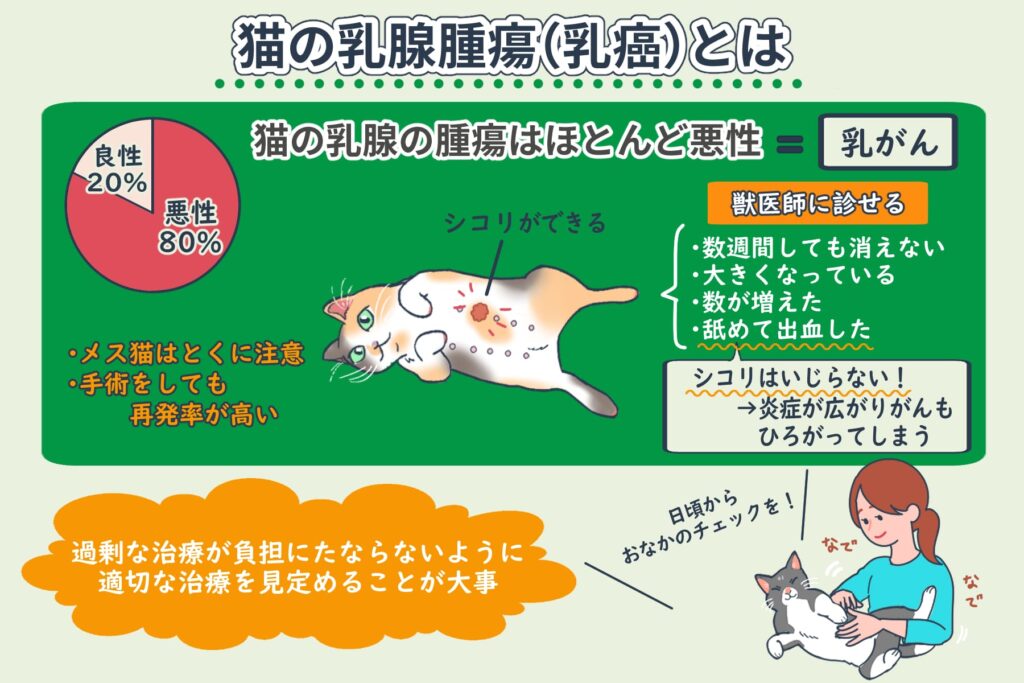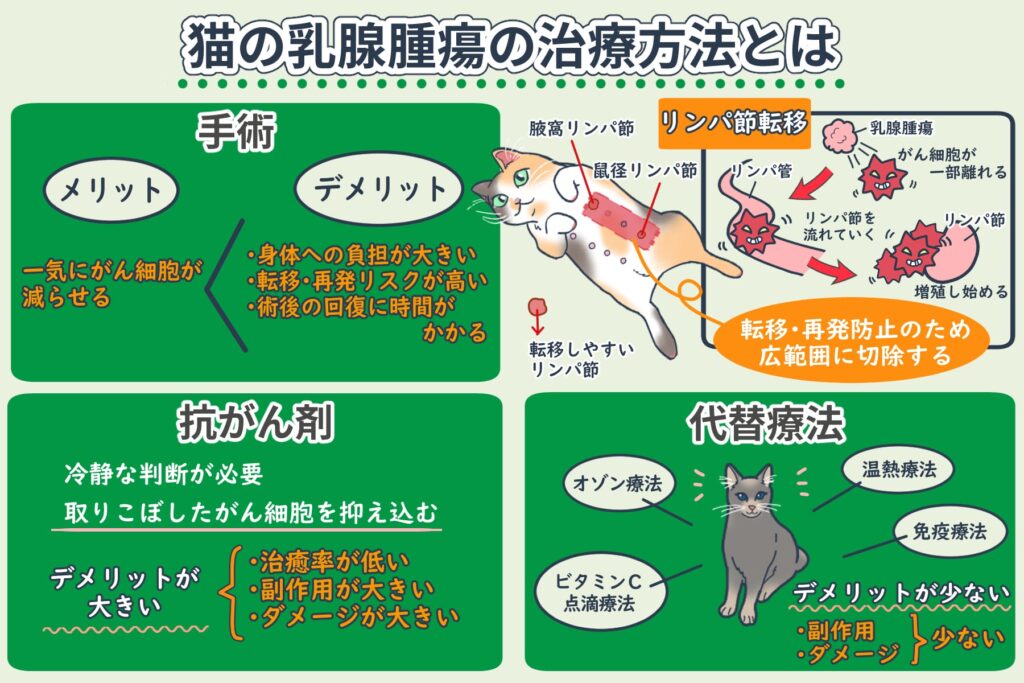This page summarizes the causes, symptoms, treatments, and tips for improvement or cure for mammary tumors (breast cancer) in cats. We introduce numerous examples of improvement. We hope this can be a source of support and a beacon of hope for you.
監修獣医師:林美彩 所属クリニック:chicoどうぶつ診療所

代替療法と西洋医学、両方の動物病院での勤務経験と多数のコルディの臨床経験をもつ。 モノリス在籍時には、一般的な動物医療(西洋医学)だけでは対応が困難な症例に対して多くの相談を受け、免疫の大切さを痛烈に実感する。
ペットたちの健康維持・改善のためには薬に頼った対処療法だけではなく、「普段の生活環境や食事を見直し、自宅でさまざまなケアを取り入れることで免疫力を維持し、病気にならない体づくりを目指していくことが大切である」という考えを提唱し普及活動に従事している。
所属:
目次
Overview of Malignant Mammary Tumors (Breast Cancer) in Cats

However, with the right approach, it is possible to manage them successfully, and in some cases, even achieve complete remission.
When treating mammary tumors in cats, the desire to “do anything for my beloved cat” can sometimes lead to unnecessary tests and treatments.
To Those Whose Cats Have Developed Mammary Tumors (Breast Cancer)
Even if your beloved cat is diagnosed with a mammary tumor (breast cancer), we want you to know that with proper care, your “cat can continue to live happily as a cat”.
Please think carefully about the treatment options to ensure you do not regret causing unnecessary burdens on your cat when looking back on the treatment.
Then, determine the most appropriate treatment and administer it to your beloved cat.
This page has been created for pet owners who are worried about their cat’s mammary tumors.
Please use it to help receive treatment without regrets.
- Case of a Dog with Advanced Mammary Tumor That Improved with Cordy Treatment
- Case of Mammary Tumor Improvement in a Dog (Maltese with Impaired Kidney Function)
- A 17-Year-Old Mixed-Breed Dog with a Self-Ulcerated Mammary Tumor That Could Undergo Surgery and Live Happily
- Case of a 17-Year-Old Mixed-Breed Dog Whose Tumor Reduced in Size with Cordy Treatment
- Case of a Cat with End-Stage Mammary Tumor That Experienced Improved Immunity and Quality of Life
High Recurrence Rate of Mammary Tumors in Cats Even with Surgery
Many veterinarians consider surgical removal first and foremost if they find suspicious lumps in a cat’s abdomen.
To reduce the rate of recurrence as much as possible, they consider extensive surgery to remove all nipples on one or both sides.
However, despite such extensive surgery, unfortunately, most cats still experience recurrence.
In the case of feline mammary tumors, no matter how much money is spent on tests, surgery, and chemotherapy, they are often cancers that do not yield results worthy of the expense.
Consider appropriately receiving the necessary treatment while also undertaking measures to enhance the treatment’s efficacy.
Our company is committed to seriously curbing the progression of feline mammary tumors.
Please consider revising your cat’s diet and working on improving its immune system, regardless of whether it is before or after surgery, or if surgery is not possible.
We believe that enhancing physical strength and immunity can undoubtedly improve the effectiveness of treatments received at animal hospitals.
For those viewing this page who have a beloved cat suffering from mammary tumors, we think our laboratory’s page could be helpful.
We have seen many cats with mammary tumors regain their vitality and appetite by boosting their immunity, allowing them to live more cat-like lives.
If you have any questions, please feel free to contact us.
First and foremost, do not overlook mammary tumors in your beloved cat

Most mammary tumors in cats are malignant.
Mammary tumors (breast cancer) are one of the diseases that female cats should be more cautious about.
Most tumors located near the mammary glands in cats are malignant, with a benign to malignant ratio of 20:80.
If your beloved cat is a girl, please regularly check her abdomen.
Even the most treacherous cancers start small and inconspicuous.
Mammary tumors can sometimes look like acne, so make sure not to overlook them.
While we don’t think you need to rush to the vet every time a small lump appears on the body surface, lumps near the mammary glands are different.
If your cat continues to lick an area causing bleeding, please have it checked out as well.
Get a veterinarian to determine whether it is a “dangerous tumor” or “nothing to worry about.”
If the tumor starts to grow rapidly, it should be considered a malignant tumor, i.e., breast cancer, and appropriate action should be taken.
As the cancer grows larger, the prognosis (survival rate) declines, so it is best to take measures as soon as possible.
Do not excessively handle mammary lumps!
Cancer also has an inflammatory aspect, and it is quite plausible that irritation can exacerbate inflammation. There is a concern that cancer could spread along with the inflammation.
Cats may lick themselves incessantly until they bleed when they start to notice something wrong. As you know, a cat’s tongue is quite rough, and it can easily peel off the skin of a tumor. This can lead to prolonged inflammation and worsening of the condition.
When tumors swell rapidly, it does not always mean that they are filled with cancer cells.
In cases of inflammation, we recommend the intake of EPA and DHA oils. Particularly, krill oil, which is extracted from Antarctic krill living in less polluted environments, is recommended because studies have shown that its absorption rate is three times higher than that of regular fish oil.
Examination of Mammary Gland Tumors in Cats

No cat owner wants to hear that their cat has breast cancer.
However, do not hesitate to get the examination.
We don’t recommend excessive and harmful testing, but that’s another topic.
First of all, it is advised to have your cat examined by a veterinarian.
Definitive Diagnosis
When diagnosing a mammary gland tumor in cats, procedures like needle biopsies are not typically performed.
The mammary gland, including the tumor, is often removed surgically. You may think this is an audacious approach, but it is considered reasonable because mammary gland tumors in cats have a high probability of being malignant.
Since definitive diagnosis involves surgery, sometimes all the mammary glands on the affected side, or even both sides, are completely removed.
To withstand the surgery, it is advisable to build up your cat’s strength and boost their immune system beforehand.
Other Examinations
After surgery for a mammary gland tumor in cats, the following examinations are performed:
- Palpation
- X-rays
- CT scans
Each of these tests is conducted to check for recurrence.
However, it is important to recognize that just because a recurrence is detected, it does not guarantee that the veterinary hospital has effective treatment options available.
In other words, these tests can essentially be considered as “tests to predict the remaining lifespan.”
The further down the list, the more expensive and the more harmful the test will be to the cat. Proper sedation is necessary for a CT scan.
The purpose of X-rays and CT scans is to look for internal anomalies, such as lymph node metastasis or lung metastasis.
Even if metastasis is detected, general veterinary hospitals usually do not have any means to address it, making these tests not particularly essential.
Considering the cost and the potential harm of CT scans, it is not a recommended method.
It is advised to have a thorough discussion with your veterinarian to determine whether a CT scan is truly necessary.
- Feline Mammary Tumors (Breast Cancer) – Causes, Symptoms, Tests, Surgery, Tips for Improvement and Cure
- Feline Cancer (Tumor) – Symptoms, Tests, Surgery, Treatment, Diet, Tips for Cancer Improvement and Cure
- Is There an Effective Treatment for Non-surgical Feline Mammary Tumors? <Cordy Consultation>
- List of Articles on Mammary Tumors
Treatment Methods for Feline Mammary Tumors

In general veterinary hospitals, surgery is the only treatment method available for feline mammary tumors.
If a recurrence occurs after surgery, re-surgery can be attempted if feasible.
However, further surgeries often only serve to distress the cat, and many hospitals will likely advise against it.
Surgery
The major benefit is the ability to significantly reduce cancer cells in one go.
Although it is an effective treatment, the significant damage it causes must also be considered.
Because anesthesia is also involved, the risk increases the older and weaker the cat is.
During surgery, the tumor and as much surrounding tissue as possible are removed.
To what extent? Typically, from the area around the armpit to the furthest back mammary gland, all mammary glands on one or both sides are removed.
Even if only one side is removed initially, the other side may be removed later.
In essence, it is common practice to remove all nipples and the lymph nodes under the armpits.
The reason for being so thorough is that if even a small amount of cancer cells are left behind, the cancer can recur.
It is believed that even at an early stage, the cancer may have already metastasized to another mammary gland, which is why a wide excision is considered appropriate.
However, despite these efforts, recurrence often cannot be prevented because many times microcancer cells that cannot be seen with the naked eye are missed.
It is common for some cancer cells to be left behind.
Therefore, it is the reality that cases of recurrence and metastasis are very frequent.
Thus, after surgery, it is important not only to hope for no recurrence but also to undertake recurrence prevention measures = immune strategies.
If all mammary glands on both sides are completely excised, it can be quite a burden on the cat.
Moreover, the recovery of the surgical wound tends to take a long time.
Therefore, if a surgery that involves removing both sides at the same time is recommended, it is advised to thoroughly consult with the veterinarian to check if it is truly necessary.
About Lymph Node Metastasis
This is lymph node metastasis.
The upper mammary glands are connected to the axillary lymph nodes via the lymphatic vessels.
The location of the axillary lymph nodes is at the root of the front leg, near the armpit. The lower mammary glands are connected to the inguinal lymph nodes at the base of the hind leg.
These areas are the common sites for lymph node metastasis.
To prevent metastasis to further lymph nodes, surgery sometimes involves excising not only the mammary glands but also the nearby lymph nodes.
This is known as lymph node dissection.
Lymph node dissection is thought to prevent systemic metastasis, such as to the lungs, but in reality, it is not very effective.
Postoperative Chemotherapy
The purpose of chemotherapy is to target the missed cancer cells.
However, unfortunately, there are not many cases where chemotherapy significantly helps cats. I believe the cure rate doesn’t even increase by 10%.
It would be good if it only provided a life-prolonging effect, but even that is not clear.
On the contrary, many cats suffer from the side effects of chemotherapy to some degree, which, depending on the severity, might even shorten their lifespan.
Is it truly necessary for a cat to undergo chemotherapy after surgery for mammary tumors?
There are not many cases where additional postoperative chemotherapy prevents recurrence and it considerably damages the cat’s body.
The disadvantages seem to outweigh the advantages.
Moreover, undergoing chemotherapy might steal precious time away from the owner and their beloved cat, which is the greatest concern.
If chemotherapy is recommended after surgery for a mammary tumor, it is crucial to carefully listen to the veterinarian’s explanation of the benefits and drawbacks of chemotherapy and make a calm decision.
Even if you are pressed to make an “immediate decision,” it is advisable not to decide on the spot but to return home and think it over calmly.
In cases of feline mammary tumors, it is not often that immediate chemotherapy is necessary.
If the situation is dire, using chemotherapy might actually be dangerous. This is because side effects manifest more strongly if the cat is in poor condition.
During the crucial period right after surgery, strive to restore strength and immunity as quickly as possible. Using chemotherapy during this critical time is strongly discouraged.
It may seriously hinder the recovery of strength and immunity, and cancer suppression by immune function becomes unfeasible.
Furthermore, it is not widely known, but there are risks associated with chemotherapy not only for the cat but also for humans. We have summarized these risks on the following page, so please take a look.
Minor Exposure to Anticancer Drugs: Risks During Pet Cancer Treatment
Other Treatments (Alternative Therapies)
Besides the above standard treatments, there are various therapies such as ozone therapy, vitamin C drip therapy, hyperthermia, and immunotherapy.
More animal hospitals are incorporating immune-boosting measures into their treatment plans.
These treatments have minimal side effects and stress on the body, making it possible to combine them.
There is little worry about treatment damage lowering the Quality of Life (QOL).
Post-surgery Care is Crucial
Why is treatment for feline mammary tumors so challenging?
The reason is the high risk of recurrence.
Treating a recurrent mammary tumor is significantly more difficult than the initial treatment.
In fact, with standard treatments, there is very little that can be done for recurrent mammary tumors.
Therefore, measures to prevent recurrence, namely post-surgery care, are extremely important.
Even if the surgery is successful in removing the tumor, there is a possibility that some cancer cells remain.
The time when the smallest number of cancer cells are present is immediately after surgery. Do not miss this crucial timing.
Improve the internal environment in a short period to prevent cancer cells from proliferating.
For this purpose, immune system measures are of utmost importance.
Efforts to Enhance Immunity
The state of immunity after surgery is closely related to recurrence.
If immunity drops, recurrence happens quickly; if immune function is stable, the chances of preventing recurrence are much higher.
To maintain good immunity, focus on providing a good diet, adequate exercise, and stress management.
Additionally, using supplements that can enhance immune regulation functions can be beneficial to achieve good conditions in a short period.
Even if surgery successfully removes cancer, underestimating the power of immunity makes it difficult to prevent the recurrence of mammary tumors.
Ultimately, it is the strength of the immune response that will confine cancer cells.
Efforts to Build Strength
As mentioned earlier, a strong immune system resides in a robust body.
To build strength, review the cat’s diet. Generally, it is recommended to provide protein-rich foods. Actively feed fish and lean meats.
It is said that you should not give anything other than cat food to cats, but this is not true at all.
Of course, “Neko Meshi” (cat food mixed with human food) is not recommended, but using human food ingredients wisely can enhance health.
Efforts to Prevent Cancer Growth
Not limited to mammary tumors, but cancer consumes a large amount of glucose for growth energy.
To suppress proliferation and metastasis at all costs, it is recommended to reduce carbohydrates in the diet.
Carbohydrates, excluding dietary fiber, do not necessarily refer to sweet foods.
In terms of ingredients, they are found in large quantities in rice, wheat, pumpkins, bananas, and potatoes. We recommend avoiding foods that contain these in large amounts as much as possible.
Also, please limit dairy products like milk. In humans, there are several reports showing a connection between milk consumption and the incidence and growth of breast cancer.
Please refrain from giving milk to cats that already have mammary tumors as much as possible.
Other Precautions
We recommend not administering any vaccines after surgery. This is because the vaccination can disrupt the state of the immune system.
Breast Cancer Prevention

Therefore, spaying your cat at a young age can block the supply of estrogen from the ovaries, making mammary tumors less likely to occur.
*Of course, there are disadvantages of spaying as well, so please make an informed decision based on sufficient information from your veterinarian.
Estrogen is also supplied from fat tissue.
In humans, obesity is one of the factors that increase the risk of breast cancer.
If your cat is overweight, please make an effort to put them on a diet.
The aforementioned restriction of carbohydrates and high-protein diets are also effective for dieting.
Your cat should lose weight while boosting their strength.
We ask you to be mindful of your cat’s immune system.
It is almost certain that immune decline is related to the occurrence of cancer.
A healthy immune system is the most crucial element in cancer suppression.
It is clear that the functioning of the immune system is greatly influenced by mental state.
Mental Care for Dogs and Cats as Part of Treatment – Coping with Illness in Dogs and Cats. Enjoying time together with their owner can improve their immune function. Moreover, when your cat wants to be alone, it is important to leave them be to avoid causing stress.
Consistent Immune Support to Prevent Mammary Tumors
Engaging in regular immune support can help in the prevention of mammary tumors.
There is no issue with giving this to healthy cats as well.
If your cat is over 10 years old or has not been spayed at a young age, consider actively engaging in immune support.
When your cat develops mammary tumors, it is very important to implement immune support measures regardless of whether or not they receive treatment.
In our laboratory, we are continuing to research whether administering Cordy during periods of decreased immunity can accelerate the recovery process.
While it is uncertain how much this treatment will respond or improve the condition, there is a significant possibility that it can at least stimulate the appetite and help in regaining energy.
When using medications such as chemotherapy agents, steroids, or antibiotics, there is a concern regarding impaired liver function. In such cases, combining these treatments with domestically produced SPF pig-derived placenta extract may help minimize damage to the liver.
Even for pets whose liver function values have already deteriorated, there are numerous cases where liver function has improved within about a month of administering the domestically produced SPF pig-derived placenta extract.
Additionally, since mammary gland tumors often accompany inflammation, it may be effective to administer EPA/DHA krill oil extracted from Antarctic krill, which is expected to have anti-inflammatory effects.
Our laboratory continues to research Cordy, which is anticipated to have immune-modulating effects, domestically produced SPF pig-derived placenta extract that is expected to protect liver function, and krill oil with potential anti-inflammatory effects. If you have any questions, please contact us.
監修獣医師:林美彩 所属クリニック:chicoどうぶつ診療所

代替療法と西洋医学、両方の動物病院での勤務経験と多数のコルディの臨床経験をもつ。 モノリス在籍時には、一般的な動物医療(西洋医学)だけでは対応が困難な症例に対して多くの相談を受け、免疫の大切さを痛烈に実感する。
ペットたちの健康維持・改善のためには薬に頼った対処療法だけではなく、「普段の生活環境や食事を見直し、自宅でさまざまなケアを取り入れることで免疫力を維持し、病気にならない体づくりを目指していくことが大切である」という考えを提唱し普及活動に従事している。
所属:
“@type”: “Answer”,
“text”: “The initial examination is crucial. First, we need to determine whether your cat has a mammary tumor or a different illness. No pet owner is prepared to hear a diagnosis of mammary cancer, but this should not deter you from pursuing the examination. Of course, unnecessary and harmful over-testing is not recommended, but that is a different matter. I strongly advise you to have your cat examined by a veterinarian.”
}
}]
}






